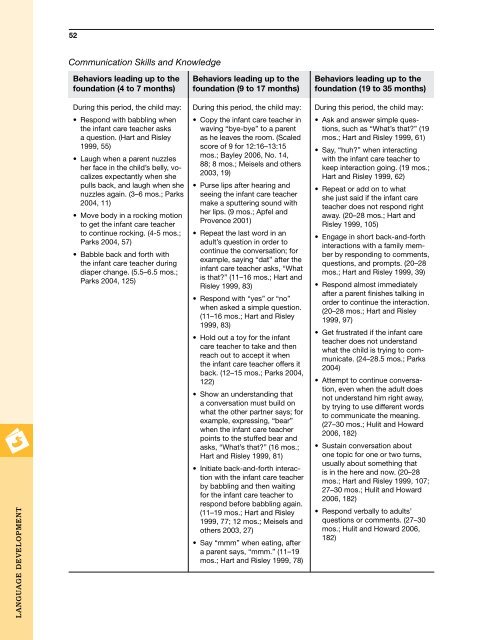Infant Toddler Learning & Development Foundations
Infant Toddler Learning & Development Foundations
Infant Toddler Learning & Development Foundations
Create successful ePaper yourself
Turn your PDF publications into a flip-book with our unique Google optimized e-Paper software.
LANGUAGE DEVELOPMENT<br />
52<br />
Communication Skills and Knowledge<br />
Behaviors leading up to the<br />
foundation (4 to 7 months)<br />
During this period, the child may:<br />
• Respond with babbling when<br />
the infant care teacher asks<br />
a question. (Hart and Risley<br />
1999, 55)<br />
• Laugh when a parent nuzzles<br />
her face in the child’s belly, vocalizes<br />
expectantly when she<br />
pulls back, and laugh when she<br />
nuzzles again. (3–6 mos.; Parks<br />
2004, 11)<br />
• Move body in a rocking motion<br />
to get the infant care teacher<br />
to continue rocking. (4-5 mos.;<br />
Parks 2004, 57)<br />
• Babble back and forth with<br />
the infant care teacher during<br />
diaper change. (5.5–6.5 mos.;<br />
Parks 2004, 125)<br />
Behaviors leading up to the<br />
foundation (9 to 17 months)<br />
During this period, the child may:<br />
• Copy the infant care teacher in<br />
waving “bye-bye” to a parent<br />
as he leaves the room. (Scaled<br />
score of 9 for 12:16–13:15<br />
mos.; Bayley 2006, No. 14,<br />
88; 8 mos.; Meisels and others<br />
2003, 19)<br />
• Purse lips after hearing and<br />
seeing the infant care teacher<br />
make a sputtering sound with<br />
her lips. (9 mos.; Apfel and<br />
Provence 2001)<br />
• Repeat the last word in an<br />
adult’s question in order to<br />
continue the conversation; for<br />
example, saying “dat” after the<br />
infant care teacher asks, “What<br />
is that?” (11–16 mos.; Hart and<br />
Risley 1999, 83)<br />
• Respond with “yes” or “no”<br />
when asked a simple question.<br />
(11–16 mos.; Hart and Risley<br />
1999, 83)<br />
• Hold out a toy for the infant<br />
care teacher to take and then<br />
reach out to accept it when<br />
the infant care teacher offers it<br />
back. (12–15 mos.; Parks 2004,<br />
122)<br />
• Show an understanding that<br />
a conversation must build on<br />
what the other partner says; for<br />
example, expressing, “bear”<br />
when the infant care teacher<br />
points to the stuffed bear and<br />
asks, “What’s that?” (16 mos.;<br />
Hart and Risley 1999, 81)<br />
• Initiate back-and-forth interaction<br />
with the infant care teacher<br />
by babbling and then waiting<br />
for the infant care teacher to<br />
respond before babbling again.<br />
(11–19 mos.; Hart and Risley<br />
1999, 77; 12 mos.; Meisels and<br />
others 2003, 27)<br />
• Say “mmm” when eating, after<br />
a parent says, “mmm.” (11–19<br />
mos.; Hart and Risley 1999, 78)<br />
Behaviors leading up to the<br />
foundation (19 to 35 months)<br />
During this period, the child may:<br />
• Ask and answer simple questions,<br />
such as “What’s that?” (19<br />
mos.; Hart and Risley 1999, 61)<br />
• Say, “huh?” when interacting<br />
with the infant care teacher to<br />
keep interaction going. (19 mos.;<br />
Hart and Risley 1999, 62)<br />
• Repeat or add on to what<br />
she just said if the infant care<br />
teacher does not respond right<br />
away. (20–28 mos.; Hart and<br />
Risley 1999, 105)<br />
• Engage in short back-and-forth<br />
interactions with a family member<br />
by responding to comments,<br />
questions, and prompts. (20–28<br />
mos.; Hart and Risley 1999, 39)<br />
• Respond almost immediately<br />
after a parent finishes talking in<br />
order to continue the interaction.<br />
(20–28 mos.; Hart and Risley<br />
1999, 97)<br />
• Get frustrated if the infant care<br />
teacher does not understand<br />
what the child is trying to communicate.<br />
(24–28.5 mos.; Parks<br />
2004)<br />
• Attempt to continue conversation,<br />
even when the adult does<br />
not understand him right away,<br />
by trying to use different words<br />
to communicate the meaning.<br />
(27–30 mos.; Hulit and Howard<br />
2006, 182)<br />
• Sustain conversation about<br />
one topic for one or two turns,<br />
usually about something that<br />
is in the here and now. (20–28<br />
mos.; Hart and Risley 1999, 107;<br />
27–30 mos.; Hulit and Howard<br />
2006, 182)<br />
• Respond verbally to adults’<br />
questions or comments. (27–30<br />
mos.; Hulit and Howard 2006,<br />
182)
















